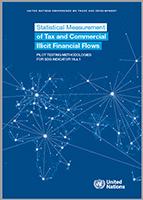
The 2030 Development Agenda defines 17 Sustainable Development Goals (SDGs) to achieve equitable and sustainable development for all, leaving no one behind. Achieving the 2030 Agenda requires targets for the SDGs to be measured via the monitoring framework, comprising 231 SDG indicators (SDG Indicators: Global indicator framework for the Sustainable Development Goals and targets of the 2030 Agenda for Sustainable Development, 2023).
Compiling and disseminating statistics on these indicators is a task, recognized by many as “unprecedented statistical challenge” (MacFeely, 2020) and requiring significant financial resources for mobilizing sufficient statistical capacity in countries world-wide, but also international agencies.
The ability to achieve the SDGs remains fragile when illicit financial flows (IFFs) continue to drain resources that are needed to fulfil human rights and pursue sustainable development. Domestic resource mobilization, assets recovery and curbing IFFs are more critical than ever. Governments’ capacities to raise resources through return of assets will be fundamental to rescue the 2030 Agenda.
The 2030 Agenda identifies the reduction of IFFs as a priority area, as reflected in target 16.4: “by 2030, significantly reduce illicit financial flows and arms flows, strengthen the recovery and return of stolen assets and combat all forms of organised crime”. This target is critical for financing efforts to achieve SDGs.
IFFs were also identified as a global priority in the Addis Ababa Action Agenda (United Nations, 2015) on financing for development which calls for a redoubling of efforts to substantially reduce IFFs, with a view to eventually eliminating them.
Regardless of its importance, data on indicator 16.4.1, “total value of inward and outward illicit financial flows”, are not yet reported as part of the SDG indicator framework (United Nations, 2017b). Comparable and reliable statistics on IFFs are needed to shed light on the activities, sectors and channels most prone to illicit finance, pointing to where actions should be undertaken as a priority to curb these flows.
This paper focuses on efforts by eleven African countries to measure tax and commercial IFFs within the United Nations Development Account project in Africa. It reviews and assesses development of concepts and methods, and their pilot testing. As such, it draws from existing work and documents of custodian agencies (e.g., (UNCTAD and UNODC, 2020; UNCTAD, 2021, 2022a)) and provides (further) methodological inputs into ongoing development of suggested statistical methodologies to measure tax and commercial IFFs and feed into global reporting on SDG indicator 16.4.1.
The paper is structured as follows:
- Chapter 2 reviews the conceptual framework to define IFFs.
- Chapter 3 details the measurement of tax and commercial IFFs by dwelling on UNCTAD Methodological guidelines.
- Chapter 4 presents the results of pilot testing and relevant methodological feedback, laying out grounds for further methodological work needed by the custodian agency of SDG indicator 16.4.1.
- Chapter 5 concludes.
This paper was prepared based on process and lessons learned within the United Nations Development Account project on “Defining, estimating and disseminating statistics on illicit financial flows in Africa”, implemented by UNCTAD and the United Nations Economic Commission for Africa.


